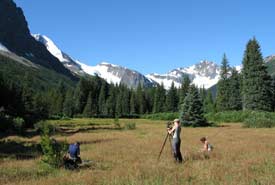Top 10 forests to visit across Canada
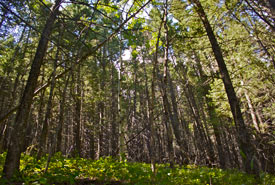
Lusicich, Crowsnest Pass, AB (Photo by NCC)
Canada is rich in forest habitats, with many unique forests in each province. Over half of our country is covered in forests, and Canada is home to almost 10 per cent of the world’s forests. The Nature Conservancy of Canada (NCC) is dedicated to preserving forests coast-to-coast, from the boreal forest in Newfoundland to the majestic coastal forests of Vancouver Island. We’ve chosen 10 of our forest properties that are publicly accessible for you to explore.
1. British Columbia's Coastal Douglas-fir forests
Chase Woods Nature Preserve is a 100-acre (40-hectare) property located on Mt. Tzouhalem in British Columbia’s Cowichan Valley. Dominated by trees clinging to dramatic cliffs rising above Cowichan Bay, Chase Woods is well-loved and travelled by locals and hikers. This old-growth forest includes centuries-old Douglas-fir and arbutus, and pockets of rare Garry oak meadow. Bats and peregrine falcon nest in the cliffs and caves on this special preserve.
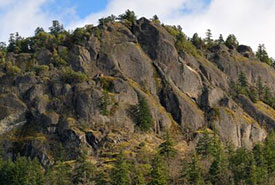
The cliffs of Chase Woods Nature Preserve, BC (Photo by Tim Ennis)
What the NCC is doing to protect it:
Old-growth coastal Douglas-fir habitats are very rare in British Columbia, and have the highest conservation value. Chase Woods is part of a network of conservation lands in the area, with NCC’s nearby Cowichan Garry Oak Preserve conserving further habitat for wildlife in the Cowichan Valley, and other areas managed by government and other organizations.
2. Alberta's majestic Crowsnest Pass
The remote Crowsnest Pass in Alberta is storied for mining, being an important railway connection through the Rockies, and the disastrous Frank Slide, where the town of Frank was lost in a massive rockslide in 1903. The Crowsnest Pass is also home to an ecologically diverse Interior Douglas-fir forest, where wide-ranging carnivores, elk and deer call home. Included in this forest is NCC’s Lusicich Estate property, where visitors who are willing to venture off the beaten path will be rewarded with a close-up experience of the Phillipps Pass, which transverses through the area and along the Crowsnest Lake, and a look at some of the province’s majestic Douglas firs.
What NCC is doing to protect it:
NCC purchased the Lusicich property in 2012, adding 263 acres (106 hectares) of important land used by wildlife to connect other ecologically protected areas to the north, south, east and west (Phillipps Pass).
Lusicich effectively acts as a bridge for wildlife between the north and south, with their access being challenged by railway lines, Highway 3, secondary roads and residential development.
3. Saskatchewan's West Parklands Natural Area - Maymont 5
On the south bank of the North Saskatchewan River, just south of the town of Maymont, Saskatchewan, is a 136-acre (55-hectare) property called Maymont 5. Many rare or endangered species make their home here, including lake sturgeon that plies the waters of the river this property hugs.
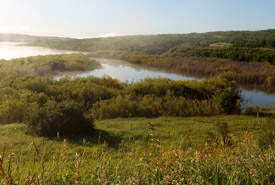
Maymont 5 property, SK (Photo by Mike Dembeck)
This area is a part of NCC's West Parklands Natural Area in Saskatchewan, which forms the southern transition to the boreal forest, a type specific to Canada's Prairies.
Visitors to Maymont 5 will find a collection of waterfowl, grassland birds and mammals — but no marked trails. You can start your journey just south of the Maymont Bridge at the barbed-wire fence entrance and walk east across the property, crossing through narrow bands of aspen forest and dry grassland knolls before climbing the fenceline to the height of land to watch the waters of the river flow by.
What NCC is doing to protect it:
Half the original West Parklands area of 5.2 million acres has been converted to agriculture and other activities, so it is important to preserve Maymont 5 and NCC’s further 2,200 acres (890 hectares) of adjacent lands in the area, to maintain a contiguous habitat for wildlife.
4. Manitoba's Elk Glen
Elk Glen is a 1,596-acre (645-hectare) property right next to the southern boundary of Riding Mountain National Park in western Manitoba. The north of the property consists of mixed-wood forest, transitioning into aspen and oak forests to the south. The olive-sided flycatcher, Canada warbler, bear, moose and elk all make their home here.
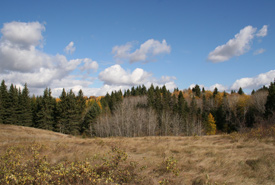
Fescue Prairie, Elk Glen (Photo by NCC)
Kevin Teneycke, NCC's senior director of conservation, speaks glowingly about the property: “Elk Glen is a wonderful example of the diversity of habitats in the Riding Mountain Natural Area. A visit to the property provides the opportunity to experience the various forest types, fescue prairie and wetlands that are found there.”
What NCC is doing to protect it:
Elk Glen’s forests are a key component of the forest matrix, providing important habitat for birds that require young forest stands and large, wide-ranging mammals. NCC’s conservation work on the Elk Glen property contributes to the ecological integrity and connectivity of the Riding Mountain uplands and Riding Mountain National Park. This project also contributes to the ecological health of the western Manitoba escarpment.
Before heading out to Elk Glen, please contact the Manitoba Region at 1-866-683-6934 to obtain permission and coordinate your visit.
5. Ontario's Happy Valley Forest
The Happy Valley Forest is a 2,850-acre (1,154-hectare) forest located in King Township north of Toronto. It is one of the largest remaining intact deciduous forest tracts on the ecologically significant Oak Ridges Moraine, and supports more than 110 bird species and a number of species at risk, including endangered plants and salamanders.
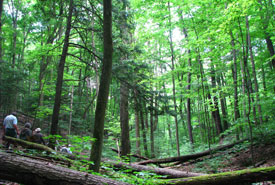
Hikers in Happy Valley Forest, ON (Photo by NCC)
Happy Valley is a shining example of the upland sugar maple and beech forests native to this area. Its old-growth features take visitors back to a time before the first loggers began cutting the forest giants of southern Ontario.
What NCC is doing to protect it:
Happy Valley Forest is as important reservoir for biodiversity in the Greater Toronto Area, and Happy Valley’s proximity to this heavily populated urban area make it an outstanding educational resource and source of inspiration for visitors. NCC maintains hiking trails and provides occasional guided tours of Happy Valley Forest for young and old alike. NCC is currently fundraising to complete the creation of a 773-acre (313-hectare) heritage forest for local residents and visitors to enjoy for generations to come.
Find out more >
6. Quebec's Green Mountains Nature Reserve
Quebec’s Eastern Townships give Montrealers a chance to enjoy nature an hour away. NCC’s Green Mountains Nature Reserve is the largest privately held Quebec conservation area; a stunning 17,300 acres (7,001 hectares) of pure, untouched wilderness. This forested area provides habitat for 20 at-risk plant species, birds of prey, such as owls and hawks, and various mammals, including bears, bobcats and moose. The forest boasts deciduous birches, beeches, ash and maple at lower elevations, which are stunning to view in the fall, and mixed-wood forests of fir, spruce and birch at higher elevations.
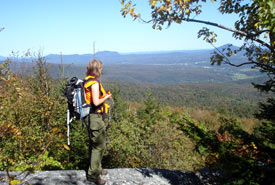
Mount Burnt property, Northern Green Mountains, QC (Photo by Appalachian Corridor)
What NCC is doing to protect it:
NCC maintains three networks of hiking trails, which allow visitors to enjoy the property. Access is provided through three points of entry. The conservation efforts in the Appalachian corridor extend well beyond this Nature Reserve, thanks to the participation of 14 conservation groups, who together protect over 27,180 acres (11,000 hectares) of land. NCC will continue to work in conjunction with its local and regional partners in order to ensure the longevity of this green, mountainous landscape so characteristic of the Eastern Townships.
7. New Brunswick's Bay of Fundy - Musquash Estuary
The Musquash Estuary is the Bay of Fundy’s last fully-functioning estuary. An estuary is a transitional space between rivers and coasts, where high levels of nutrients make estuaries one of the most biologically productive environments in the world. The massive area — 4,233 acres (1,713 hectares) — covered by the Musquash Estuary is home to six important habitats from the Bay of Fundy region, including coastal forests. The NCC has established and maintains two hiking trails, which give visitors an immersive experience in this ecologically diverse area.
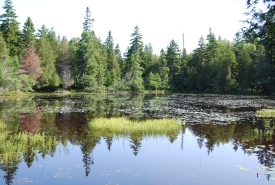
Musquash Estuary, NB (Photo by NCC)
What NCC is doing to protect it:
In July 2016, the Musquash Estuary celebrated 10 years as New Brunswick’s first Marine Protected Area. This federal designation ensures the protection of the marine habitats under the Oceans Act with the Federal Department of Fisheries and Oceans.
The Nature Conservancy of Canada has protected forests, salt marshes, bogs and coastline surrounding the Marine Protected Area.
8. Nova Scotia's Gaff Point
If you’re looking for a coastal hike on Nova Scotia’s South Shore, Gaff Point near Lunenburg, Nova Scotia, will reward you with thrilling views of the ocean. The trail starts on a white sand beach, meanders and climbs through a rugged and windswept conifer forest, and opens up to heaths and grasslands overlooking the shore below. Whales, seals and a variety of birds are just some of the wildlife you’ll see on a hike to Gaff Point. A seven-kilometre hiking trail is accessible off Hirtle Beach.
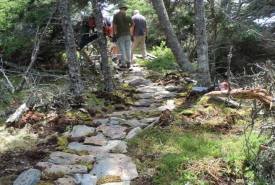
New pathway, Gaff Point, NS (Photo by NCC)
What NCC is doing to protect it:
Gaff Point is one of the few remaining wild and undeveloped coastal areas on the South Shore. NCC works with the Kingsburg Coastal Conservancy to steward the land at Gaff Point and protect this important wilderness area.
9. Prince Edward Island's Boughton Island
Boughton Island is PEI’s third-largest island and has been completely uninhabited since World War II. Wildlife diversity has bloomed on Boughton, and locals often take day trips to Boughton to try to catch a glimpse of the bald eagles, great blue herons and the endangered nesting piping plover. Its diverse habitats include six kilometres of pristine shoreline and spruce forests, which you can enjoy with walks through old roads constructed before the island’s limited settlements and lobster cannery were abandoned.
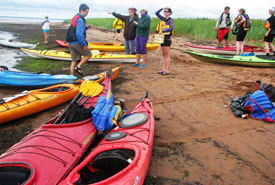
Conservation Volunteer event, Boughton Island, Prince Edward Island (Photo by NCC)
What NCC is doing to protect it:
NCC was a catalyst for Boughton Island’s protected status and still plays a management role. Organized Conservation Volunteers events keep Boughton Island clean and safe for its many wildlife species.
10. Newfoundland: Boreal forest and the Salmonier River
The Avalon Peninsula of Newfoundland is home to North America’s most easterly forest. The forest consists primarily of stands of balsam fir, with white and yellow birch interspersed. This unique forest habitat also has a high diversity of lichens, believed to be unmatched when compared to the boreal forests of the rest of Canada. Many of these species are uncommon, declining or at risk worldwide, such as the endangered Atlantic population of boreal felt lichen.
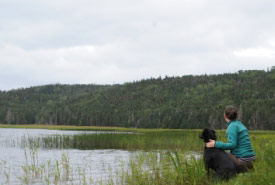
Lanna Campbell and Polly look out over the Salmonier River (Photo by Trevor Nickerson)
What NCC is doing to protect it:
The Salmonier River Conservation Project is just northeast of Mount Carmel-Mitchells Brook-St. Catherines, Newfoundland. It consists of 436 acres (175 hectares) of private land on the shoreline of the Salmonier river. The river is bordered by freshwater wetland habitat, and is a provincially designated salmon river. All lands that NCC currently owns and will acquire as part of the Salmonier Conservation Project will continue to be accessible to the public, including existing trails.
This post originally appeared in the Globe and Mail and was produced with the support of Randall Anthony Communications Inc.

